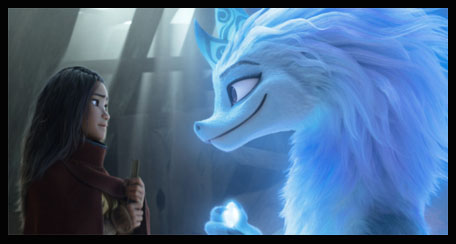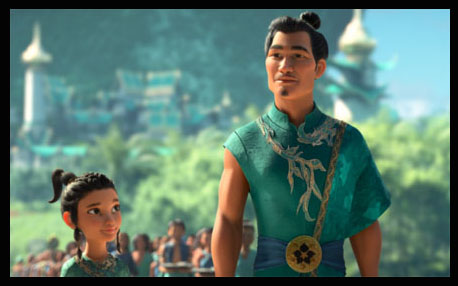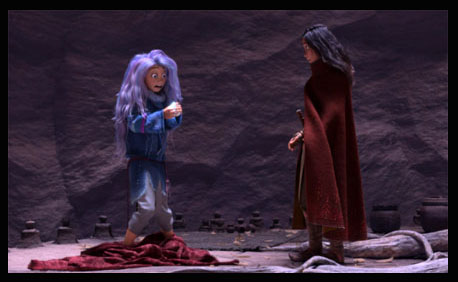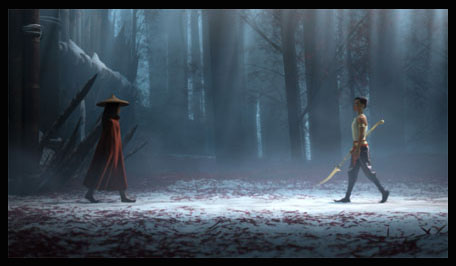
Disney Animation’s new feature Raya and the Last Dragon opens in theaters and debuts on Disney+ Premier Access this Friday March 5th. Five of the film’s makers discuss all that went into the movie, from story to visuals to release strategy. These interviews were edited for length.
Jackson Murphy: Adele and Osnat, you announced Raya at D23 in 2019. How do you feel about the film FINALLY being released?
Adele Lim (Writer): We’re so excited because this is like having a baby that we’ve had for so many years. We’re finally able to share it with our friends and the rest of the world. For them to see what we’ve been slogging at for the last few years!

Osnat Shurer (Producer): You lose a sense of time, especially when the last year’s been at home. The whole process, and there’s so many stages of making a film. So many ups and downs. So many milestones. It’s hard to believe we’re here. But to tell you the truth, I just can’t wait to share this movie with the world – not just because we’ve been working on it for so long… but also because it feels like super timing with the messaging. It’s a message about coming together and looking at the differences among us and instead of seeing them as something to divide upon… it’s to embrace it and come together for the greater good. What could be more timely?
JM: As I was watching the film, there are sort of two momentums. There’s the present day narrative and then you’ve got the prologue and other key flashbacks. Which element was the most difficult to craft perfectly?
AL: Very astute observation. And I think the thing we knocked our head against the wall the most was the prologue. We actually have three different time periods: the ancient history of when the prologue happened, Raya and her father and present day in Kumandra when Raya has grown up a little bit. Finding a way to balance between those three time periods all in the first act was incredibly difficult. And I think there’s been as many different prologues as we’ve had screenings or versions of the script.
JM: Walt Disney Animation Studios has given us so many strong animated leading ladies, especially over the past decade. What makes Raya like those other leading ladies, but also different than them?
AL: I think the Disney heroine has always been an inspirational and aspirational figure for so many young girls around the world. Because of that, Raya absolutely sits in that same space. But the way in which she’s different: We’ve had conversations [about] why she should be a princess and we decided that she should be a princess because of the extra burden on her. But really, more importantly, and much more relevant for the kids watching it today, is that she was brought up to be a leader. And she is in a broken world. And she’s taking on that mantle of leadership even when she’s lost everything. Even when she’s faced with staggering odds. She keeps fighting. She keeps pulling her people together. And she’s flawed. She is relatable in that she’s also disheartened and disillusioned by the world, but she finds a way to see past and see beyond that. Doing the hard work of pulling people together, even though she might get betrayed, even though she might fail… pulling people together is the only way we’re going to move through all of this together.

JM: Paul, how do you keep track of all the items you animated and use, like at the marketplace in Talon?
Paul Felix (Production Designer): It was a huge challenge, but I guess we just really had to be clear about what we want to see when and how it was used. There’s a lot of working back and forth between the art department and layout and modeling. We start to get very simple models up and running so the cameras can be put in them so we can get a sense of what exactly is being seen. That kind of addressing that continues all the way through layout and after layout. There was so much stuff that had to be built. It was a lot of back and forth and building it stage by stage – just to make sure we’re not doing more than what the camera needed to see.
JM: The landscapes (including the desert) are gorgeous. And one of the main promotional images of Raya is her in the rain. Adolph, what kinds of studying of weather goes into making these sequences?
Adolph Lusinsky (Director of Cinematography – Lighting): We were inspired by Southeast Asia, which is a somewhat humid place. You can get more atmospherics there than maybe you would in the desert. That was the original inspiration. Then it was about: “How do we contrast that?” With the desert, we played it much more stark and made sure we had things like dust and dust devils that we specifically developed for this movie – to really contrast all the mist in place that was inspired by the region. It really added a lot of depth to the lands. All the complexity of the environments like Talon: part of Lighting’s challenge was, “How do we simplify that so you know where you’re supposed to look?” Or else it’s visually chaotic. We found that using atmospherics like steam and things like in that marketplace really helped simplify the visual language – yet you have all those details but in a very organized way.
JM: Rob, can you tell me a little bit about the importance of the camera being eye-level with the characters?
Rob Dressel (Director of Cinematography – Layout): Where we place our cameras – both height and side to side – often centers around the connection with the characters for the audience and what level we’re being at throughout the story. And we found that by being closer to eye-level it gets us a little more connected, like we’re speaking to them. And then by going with our lower or even higher angles, it gives a more dynamic look to the character and it’s not what we’re used to seeing.
JM: Paul, how did the film’s core theme of trust really hit home for you in making Raya?
PF: A lot of that thematic lies in the cinematography plan that we came-up with. There are specific rules that relate to trust as opposed to distrust. We talked about them for a year before we went into production. The three of us came-up with a plan for how we visually represent those in the cinematography because that’s where that thematic is most strongly felt.

JM: In the beginning portion of the film, there are some key sequences in the dark. Adolph, is it as challenging as it looks to really make an animated sequence in the dark?
AL: Yeah. There were a few challenges we had with the darker sequences. One: what we were asking the lighters to do is: even though it’s dark, we still wanted to make sure we saw strong value structures. If it was dark… maybe we don’t see the character but they’re still silhouettic and maybe over some backlit fog or mist. Even though it’s dark, we wanted clarity in what you’re seeing. And we didn’t want a low contrast where everything is dark. And the second thing was just the challenge in pushing the lighters… usually we don’t let a character be completely dark. “We put work in animating this. We want to see it!” But we got a [message] from the directors early on that we could really push things in that way – and that was something the artists had to get used to and we needed to push on early in production. We really want there to be almost no fill light and let things go really stark. It was unique to this movie.
JM: One of the things writer Qui Nguyen has said is that “Raya, at its core, is an action movie.” And it’s unique in that sense to the Disney Animation library. Rob, were there specific challenges because of the action and the movement of these characters – as opposed to other films and projects you’ve worked on?
RD: We really knew we wanted to set a new bar, especially because of multiple fight sequences. Early on we wanted to make sure that each fight had a different style to it – not just fighting style, but visually. And that would depend on what part of the movie we’re in. There’s a fight between two characters that are just bantering back and forth, so we shot that one way. But when the two characters are raging against each other, it’s a whole different feel. The cutting style… everything was different. So we wanted to make sure each one had its own place in the film. And then the big thing was: because this movie was inspired by Southeast Asia, we wanted to make sure the fights were real fights with real moves that could really happen – not just fantastical, magical jumping and flying. Working with Qui and our Southeast Asian partners, we were able to craft these really cool fights with double swords and the big broadswords. Some of the grappling moves and punching and kicking that’s really hard and fierce. Just great to incorporate. But we had to work with the choreography and the animation team to figure out what we were gonna use and how to stage it, so a lot of levels of detail.

JM: I’m glad. And Adolph, you’ve worked with co-director Don Hall on Big Hero 6, Moana and now this. How has your relationship strengthened over the course of these three films?
AL: That’s a good question because I feel like a lot of moviemaking is about the relationships between us. The three of us worked on Big Hero 6 with Don and Rob and I on Moana. There’s a lot of understanding between each other and trust with each other. And with Don, it’s the same thing. We kind of know what he wants. Don is all about story and doesn’t mess around. Everything we do has to support that particular story moment. And that really is part of the driving force when we were developing our cinematography plan: really grappling onto the thematics of this film and mapping that out with the story arcs and working with Don that way. To be able to do that with Don was because of the past relationship we had. That previous relationship is invaluable.
JM: Osnat, I can imagine that as a producer you spend many years on this and you plan ahead. And then something like COVID happens and the world shifts. How did you have to pivot?
OS: I think animation has a lot of pivoting in it along the way. It sounds like it’s four years and it’s all the same. We’re constantly changing direction. We’re constantly honing and getting clearer and clearer. I couldn’t have planned for COVID, and honestly if you had asked me before it hit if we could do this, I would’ve said, “Absolutely not. We cannot make this movie from home. Are you kidding me?!” And then March hit, and we get the go-home notice (for three weeks, we think). It’s been a whole year. We pivot quickly. We have amazing technology teams that get us all connected. But the bigger thing we had to overcome was cultural. We like to work together in a room and build on each other’s ideas. We solve so many things over lunch. I like to feed my crews when they’re working hard. None of this stuff happens in Zoomland. So we had to find new ways of collaborating. We had to narrow down our hours, which created a better work/life balance. But made us have to delegate and trust each other more.
JM: I’m near Albany, NY, and we’ve had indoor theaters open here since October. The Drive-Ins will probably be open in the next month or so, and I’m sure it will do really well. But in New York City, their theaters are gonna open their doors for the first time in 350 days with this movie. What does that fact alone mean to you – for one of the biggest movie markets in the world?
OS: I think there’s a whole question with each person of how comfortable they are to go somewhere – to go to a public place. As far as I know, it’s permission to open, so they have to choose if they open. But it’s super exciting. It felt really auspicious. We’re like, “That is cool! That is very cool.” We’ve been looking at every single region in the world… and in each place, it’s coming out one way or another. Obviously, the more it is in movie theaters, the more it is on Disney+ wherever Disney+ is available, the more exciting it is for us because we want everyone to see it.
- INTERVIEW: Jeff Fowler On “Knuckles” And “Sonic 3” - April 22, 2024
- INTERVIEW: “Inside Out 2” Director And Producer On Pixar Sequel - April 16, 2024
- INTERVIEW: “Puffin Rock And The New Friends” And 25 Years Of Cartoon Saloon - April 10, 2024


 March 2nd, 2021
March 2nd, 2021  Jackson Murphy
Jackson Murphy  Posted in
Posted in  Tags:
Tags: 






